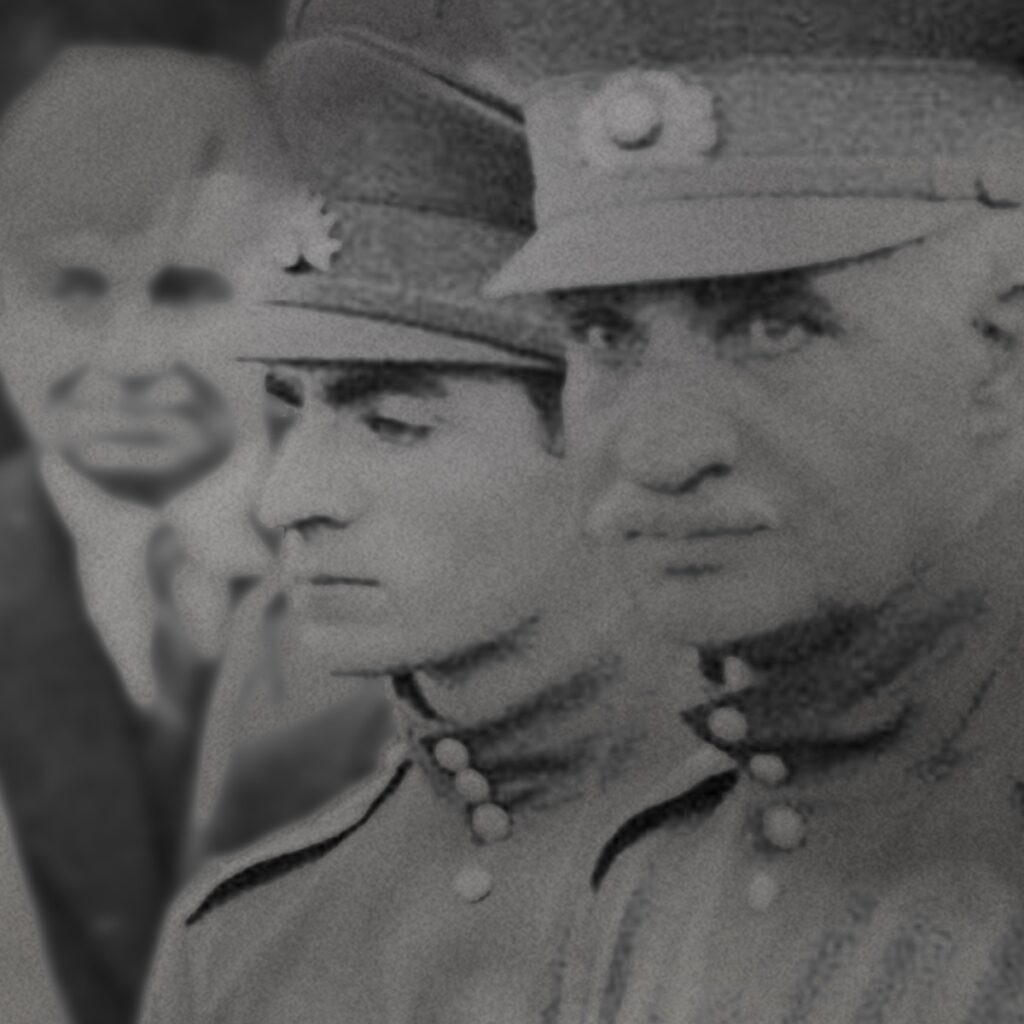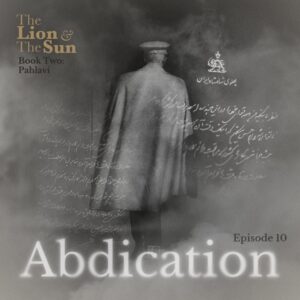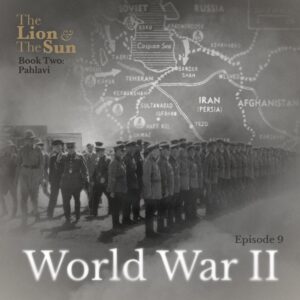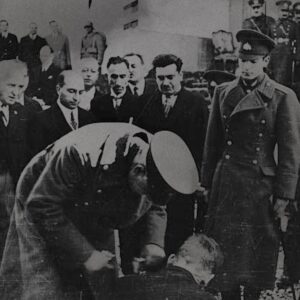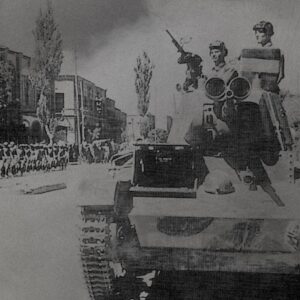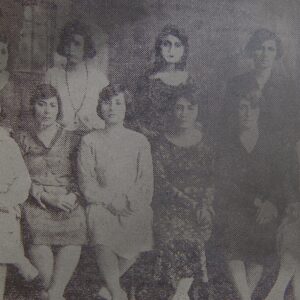This is the transcript for Book Two, episode 5 of The Lion and the Sun podcast: The Heir. As Mohammad Reza Pahlavi is named the crown prince, he goes through a rigorous training, supervised by his father, to prepare for the throne.
Listen to this episode on Apple Podcasts, Spotify or all other podcast platforms.
The clock rang eight times.
It was an old clock.
One of those passed down through generations.
Its slow, steady ticks echoed through the silence, as if the house itself was waiting for something to begin.
The building was small. The walls were worn.
But for its residents, it felt like a mansion.
The windows let in the first light of day.
The wind carried a cold breeze, still touched by the remnants of night.
It was fall, but the weather was still fresh.
The residents were a young couple. An officer from the Cossack Brigade, and a young woman who was nine months pregnant.
They had recently relocated to Tehran, full of ambition.
They had come to build a future.
And now, they were waiting to welcome their first child into the world.
Birth of a Future King
A few minutes later, the silence was broken by the sharp cry of a woman.
The midwife rushed into the inner quarters.
The young soldier stood outside … waiting. Restless.
He already had a daughter from his first marriage and a daughter from his current one.
But this time, he was hoping for a son.
In ancient Iran, sons were everything. They carried the name, the inheritance, the family’s future.
This belief was rooted in centuries of patriarchal tradition. Reinforced by law and custom, and it endured into the Qajar period.
Time passed.
Then, at around 8:15, the cry of a newborn filled the air.
The midwife opened the door. The soldier rushed toward her, heart pounding.
“Is it a boy?”
“They’re twins,” she said. “One is out. One more is coming.”
“But is it a boy?”
“Yes, the first one is a baby boy but we’re not sure about the second …”
She kept speaking, but he didn’t hear the rest.
He didn’t need to.
His chest swelled with pride.
He finally had a son. Someone to carry his name.

Reza Khan didn’t have much at the moment.
But he was ambitious. And he needed a son to build on what he had started.
And unbeknownst to him …
That legacy would soon include the entire kingdom of Iran.
The Pahlavi family had just welcomed its successor.
The future king of Iran.
The Early Marriages of Reza Khan
Reza Shah’s personal life was as full as his political one.
With four wives and eleven children, he left behind a sprawling family at the time of his death in 1944.
His first marriage came long before his rise. Before the prime ministership, before the throne, even before he climbed the ranks of the military.
When he was just a young boy, he married Taaj Maah, his cousin. They had one daughter: Fatemeh, later known as Hamdam-ol-Saltaneh.
But the marriage didn’t last as it ended after Taaj Maah’s sudden and unexpected death.
Taj al-Molouk: The Woman Who Raised Iran’s Last King

In 1916, Reza married Taj al-Molouk, the daughter of a cossack officer.
At the time, Reza was still just an officer in the Cossack Brigade. One of the most powerful branches of the military that was formed after Nasir al-din Shah’s trip to Russia.
To start a family, he rented a modest house in Sanglaj. Within five years, they had four children:
Shams, Mohammad Reza, Ashraf, and Alireza.
After Reza Shah’s coronation, Taj al-Molouk was elevated to a powerful position of Queen and she kept that influence throughout his reign and even after.
Though his marriages were shaped by political considerations, Reza Shah was deeply involved in his family life. He often shared meals with his children and tried to maintain a steady connection with them.
Still, the household wasn’t without tension.
Taj al-Molouk, known for her strong will, struggled with jealousy, especially after the king’s later marriages. But through it all, Reza Shah’s family remained central to both his personal and political world, and his children would go on to play a key role in the future of the Pahlavi dynasty.
Reza Shah’s vision for Iran was not limited to sweeping modernization programs, centralization of power, or the expansion of infrastructure. One of his most personal, long-term projects was shaping a successor.
As a former minister of war and prime minister under the Qajars, he had seen how incompetent heirs could ruin a dynasty. He was determined not to let history repeat itself.
He didn’t just want someone to inherit the crown … he needed someone to carry his vision of a new Iran.
Why Was Mohammad Reza Pahlavi Chosen Crown Prince?
While the king had four wives and eleven children, the issue of succession wasn’t as complicated as it might have seemed.
When the constitution was amended to pave the way for Reza Shah’s rise to the throne, the Constituent Assembly introduced strict safeguards regarding succession:
The crown could only pass to Reza Shah’s male descendants, in direct line, born of an Iranian mother.
And most importantly, no one of Qajar descent could be eligible.
Reza Shah had a daughter from his first marriage.
His third and fourth wives, Turan and Esmat al-Molouk, were both Qajar princesses. And although he had four sons and two daughters by them, their Qajar blood excluded them from the line of succession.

That left only two contenders:
Mohammad Reza and Alireza, sons of Queen Taj al-Molouk.
Despite Taj al-Molouk reportedly favouring her second son, it was Mohammad Reza who was formally named as the king’s successor.

Raised to Rule: How Reza Shah Shaped His Son into a Monarch
From the moment he named him crown prince, Reza Shah approached fatherhood more like a head of state than a parent. The boy was separated from his mother and sisters and placed in a tightly controlled environment. There, everything from his daily schedule to his table manners was curated. He was expected to learn languages, absorb military discipline, and grow up with a sense of detachment from emotional indulgences. Sent abroad to study, his life was monitored from a distance, with the precision of a general inspecting the front.
But the heir’s upbringing was not just a matter of education …it was a political act. Mohammad Reza Pahlavi represented the continuity of the dynasty, and more importantly, the durability of the project Reza Shah had started.
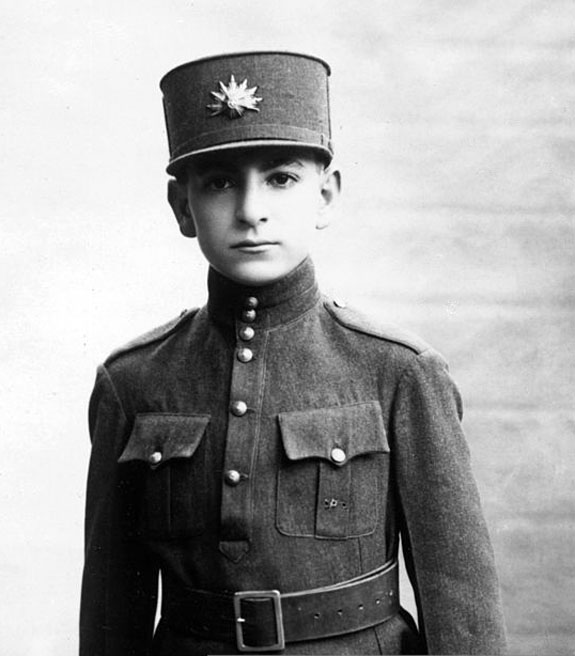
If the founder of the Pahlavi state had broken with Qajar decadence, then the prince was to be proof that this rupture could hold across generations.
Born in a Rented House, Raised for a Throne
Mohammad Reza Pahlavi was not born into majesty, but into transition.
His birth in 1919 came at a time when his father, not yet Shah, was a military man on the rise. An ambitious figure with a vision for transforming both himself and the country. The house he was born into was modest, rented, and tucked in the neighbourhood of Darvazeh Qazvin in Tehran.
But modesty would be short-lived.
Within three years of his birth, his father would seize power in a coup, setting into motion the foundation of a new dynasty.
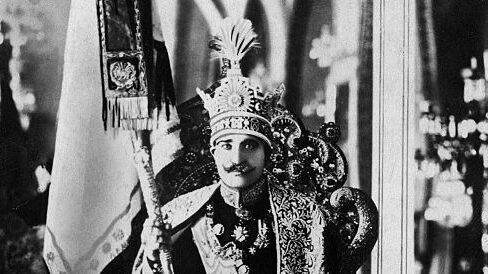
Even before the crown rested on Reza Khan’s head, he had begun building the image of a new Iranian elite. Disciplined, modern, and rooted in nationalist myth. As the first-born son, Mohammad Reza was placed at the center of this vision. He was cast not only as an heir but as a vessel of continuity. Someone who would legitimize the break from the Qajar past while ensuring the durability of the Pahlavi future.
From Coronation to Classroom: Mohammad Reza’s Life as Crown Prince Begins
When Reza Khan became king, Mohammad Reza Pahlavi was right there. Standing next to him in the coronation ceremony, as Foroughi was giving his notes and Teymourtash was handing the king the freshly crafted Pahlavi crown. The crown that one day would rest on his own head.

At seven years old, he was declared crown prince. That moment marked the beginning of a highly controlled education that was as much political indoctrination as it was schooling. He was removed from the domestic sphere and placed in a specially designated royal residence within the Golestan complex.
From there, he entered a custom-designed private school, surrounded by hand-picked classmates. The pretense was to raise him as a student among students, but everyone knew who he was.
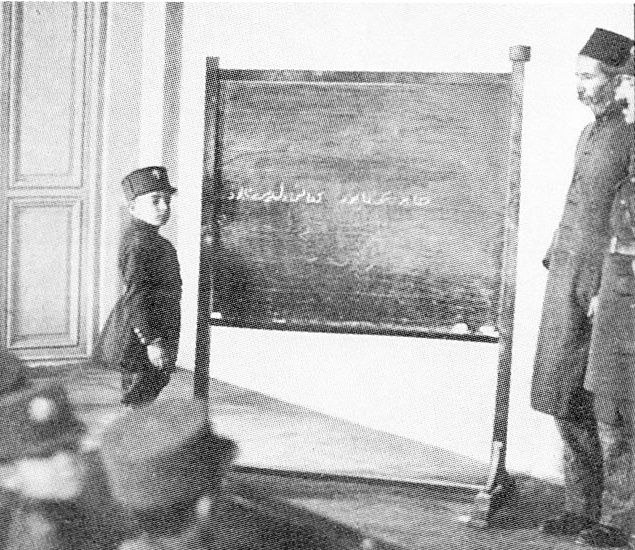
The fiction of normalcy couldn’t survive the weight of his title.
His father, now Reza Shah, ruled like an engineer rebuilding a broken state. His son’s formation followed a similar blueprint: structured, hierarchical, and intensive.
Language was crucial: French, the language of diplomacy; English, the language of power; and Persian, refined and formal, the language of national identity. But more than grammar and geography, Mohammad Reza was being trained to carry himself like a monarch in waiting.
Institut Le Rosey: The Swiss School That Moulded a Shah
At the age of eleven, he was sent to Switzerland, a country neutral enough to avoid entanglements, yet Western enough to serve as a model for the kind of progress Reza Shah admired. But the distance came with a cost.
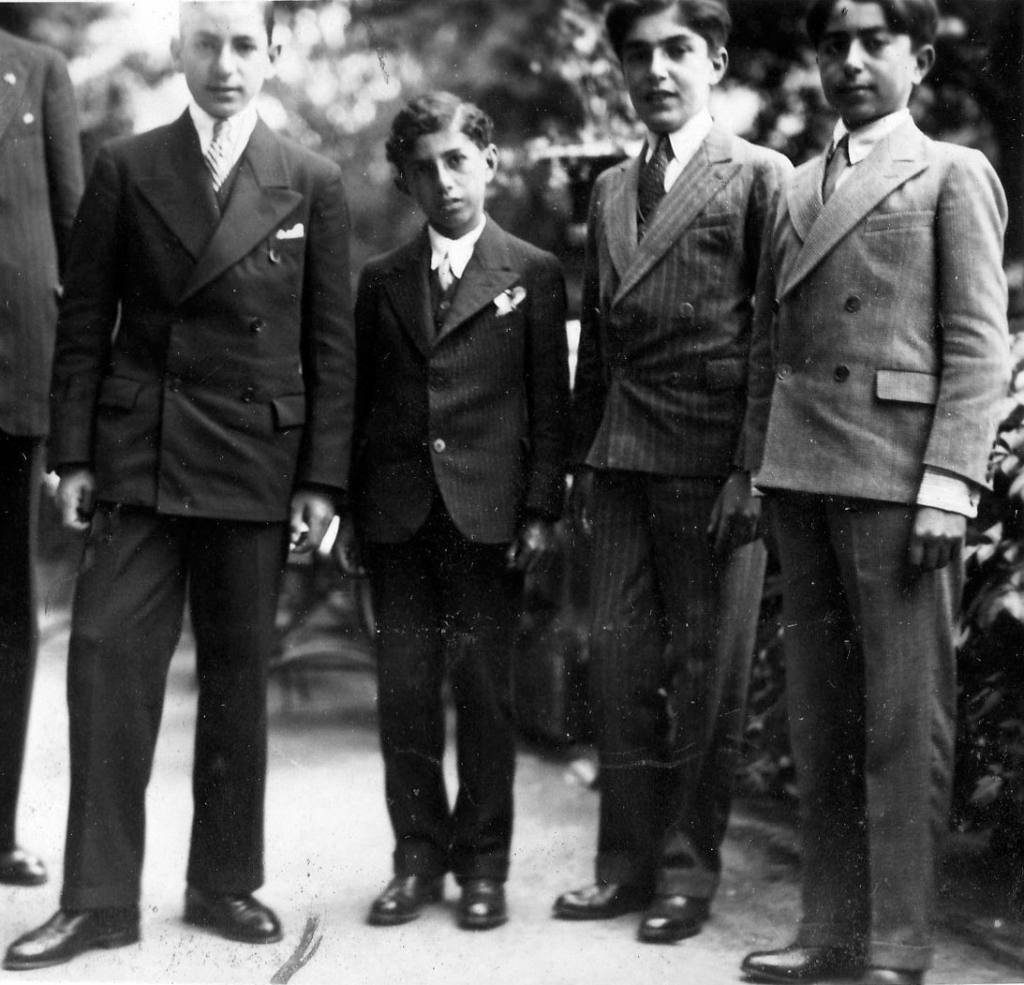
The young crown prince found himself isolated, overwhelmed by the academic pressure, the rigid expectations of his Persian tutors, and the weight of the role he was preparing for.
While in Switzerland, Mohammad Reza Pahlavi, the future Shah of Iran, wrote letters to his father, opening up about his personal thoughts and emotions, especially during times of political tension. These letters give insight into Mohammad Reza’s relationship with his father, his emotional state, and the challenges he faced during the exile:
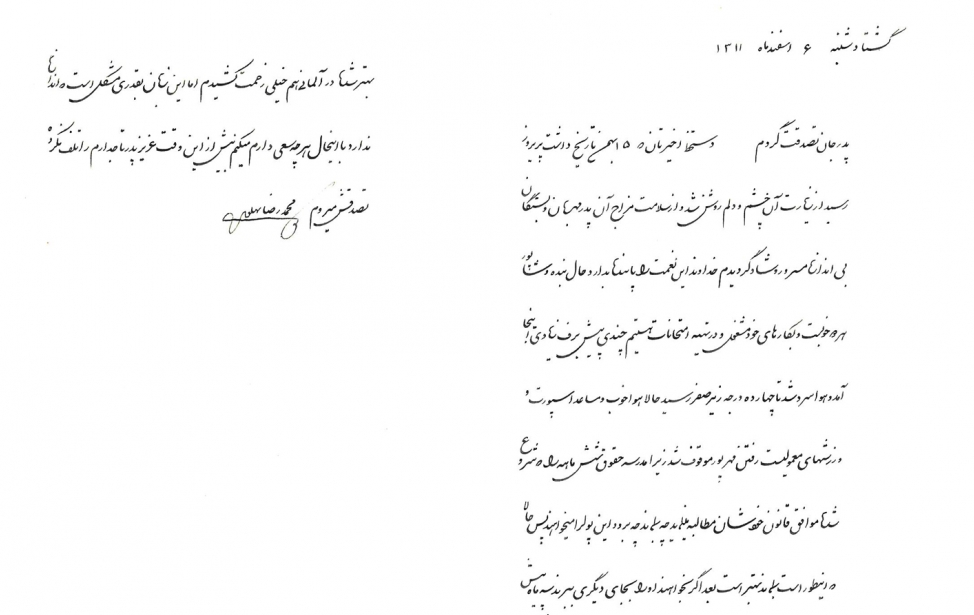
Your Majesty, my esteemed and beloved Father,
I am deeply honoured by your kind presence in my thoughts. I received your recent letter, dated the 14th of Bahman, just two days ago. Upon reading it, my heart and mind were filled with great joy, and I was immensely pleased to hear of the continued health and well-being of your esteemed self, as well as that of our dear relatives. May God continue to bless and protect these precious gifts.
I, too, am in good health and engaged with my various responsibilities. At present, I am focused on preparing for my exams. A few days ago, we experienced snowfall, and the temperature dropped to fourteen degrees below zero, but the weather has now improved and is quite favourable.
These letters—sent weekly without fail—were less private correspondence and more ritualized reports. The tone throughout was careful, ceremonial, and emotionally restrained, yet threaded with efforts to express admiration and gratitude.
What Did Mohammad Reza Write to His Father From Abroad?
Despite his central role in shaping his son’s future, Reza Shah remained emotionally distant. Mohammad Reza was closer to his mother, Taj al-Moluk, and formed a lifelong bond with his twin sister, Ashraf. In contrast, the father-son relationship operated within a formal structure, underscored by silence and expectation.

Even during family meals, Reza Shah’s reserved nature and straight-laced demeanour rarely gave way to softness. He was respected, even feared, and not easily approached.
Provision came more easily to Reza Shah than affection. He gave generously in material terms: cars, gold watches, and toys for his sons, but rarely allowed this generosity to be accompanied by visible emotional warmth. He withheld physical affection and touch to his heir, fearing the development of homosexual tendencies and much like the elders of that generation, kept a formal distance from the prince.
His instincts were more authoritarian than paternal, and his guarded, secretive temperament left little room for emotional transparency.
Over time, subtle shifts appear in the letters.
As Mohammad Reza Pahlavi matured, his writing grew more confident. He occasionally referenced military matters, showed interest in national affairs, and even made mild recommendations regarding individuals connected to the court. His tone remained reverent, but the language revealed a young man gradually internalizing his future role.
Becoming a Soldier: The Military Training of Iran’s Crown Prince
When Mohammad Reza returned to Iran at the age of seventeen after five years in Switzerland, his transition from student to officer (and eventually to monarch) accelerated under the close supervision of his father. Reza Shah, now firmly in control of the state, set about the final stage of shaping his son into a sovereign fit to carry the weight of the Pahlavi dynasty.
Reza Shah had begun his career as a military officer. Throughout his ascent to power, he considered himself first and foremost a soldier. His coronation famously happened with his military attire and he would often wear his military uniform and boots everywhere he went.
Naturally, he wanted his son to follow the same path and to be trained in the rigid military structure.
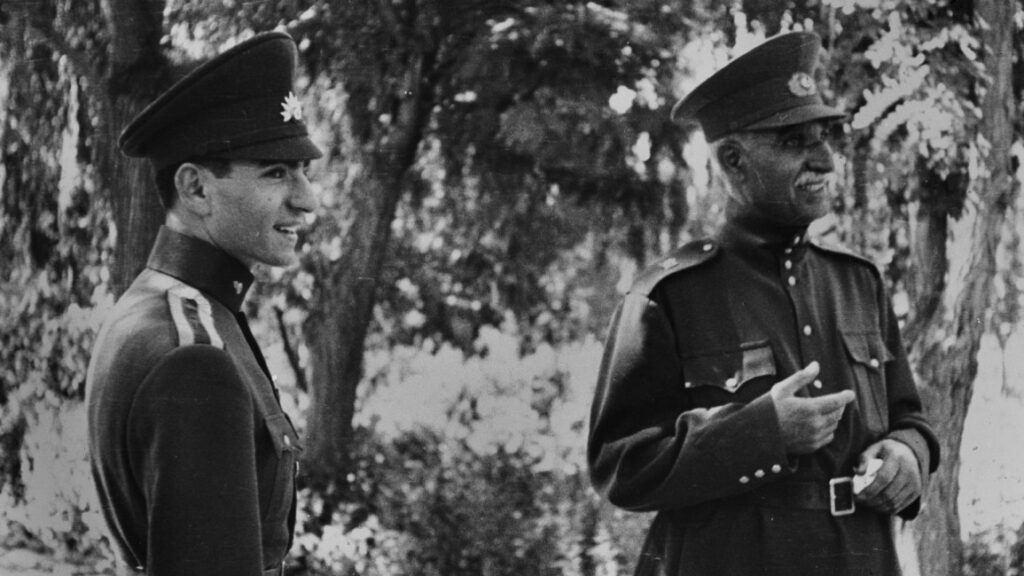
Upon his return, Mohammad Reza Pahlavi was enrolled in the Officer’s College, where the military curriculum was modelled after the elite Saint-Cyr academy in France. The choice reflected Reza Shah’s belief that kingship in the modern age required discipline, technical knowledge, and a firm grasp of military order.
Within two years, the young crown prince graduated with the rank of second lieutenant, prepared to step into a public role defined by uniform and command.
A Complicated Bond: Mohammad Reza and His Father, Reza Shah
The young heir absorbed many of the ideals imposed on him, but not all in the way his father might have intended.

The crown prince internalized discipline, loyalty, and nationalism … but he also developed a deeply reverential, even spiritual language that stood in contrast to his father’s stark secularism.
He was not a voracious reader, nor was he drawn to ideological discourse, but Mohammad Reza Pahlavi showed a quiet attentiveness to culture and aesthetics. This set him apart from his father’s more brusque and militaristic character. Where Reza Shah had little patience for ambiguity, the son was more impressionable, prone to contemplation, and, at times, dependent on the affirmation of those around him.
Where Reza Shah’s authority came from power, reform, and history, his son spoke in terms of divine favour, blessings, and sacred mission.
This difference in language hinted at a deeper divergence.
Reza Shah’s version of Iranian modernity demanded that religion recede from public authority. His modernization was anti-clerical, deeply tied to the idea that Iran must break free from the hold of tradition if it were to survive as a strong, independent state. Mohammad Reza, in contrast, came of age in an era when religion was increasingly seen by Western powers as a bulwark against communism and by many Iranians as a source of cultural identity in a rapidly changing world.
The father saw the clerical establishment as a political adversary.
The son would later treat it as a strategic partner.
A Royal Marriage: Why Mohammad Reza Married Princess Fawzia of Egypt
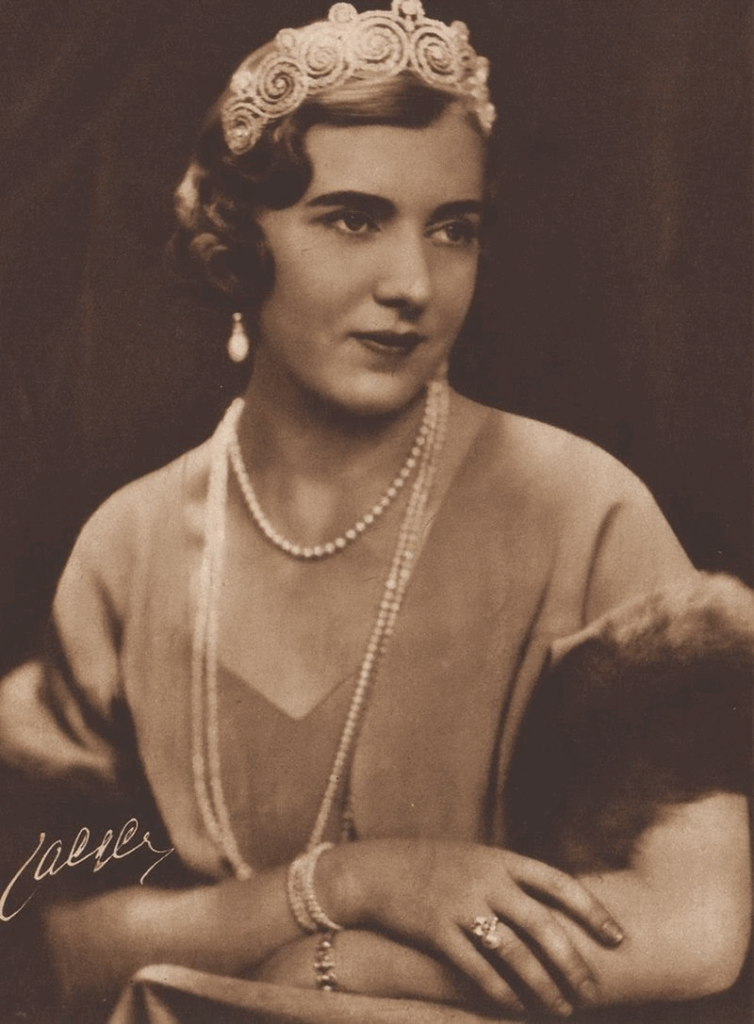
After graduating from the military school, it was now time for the heir to take a wife.
The first choice was Princess Ingrid of Sweden, and then a Qajar princess, but Mohammad Reza ultimately married Princess Fawzia, who was the sister of King Farouk, the monarch of Egypt.
The match with Egypt was politically advantageous.
In the late 1930s, both Egypt and Iran were seeking to strengthen their positions in the Middle East. Farouk’s Egypt and Reza Shah Pahlavi’s Iran were united by shared interests in modernizing their countries and asserting their influence in the region.
For Reza Shah, who was focused on strengthening the Pahlavi dynasty, the marriage was a way to align with another powerful monarchy in the region. Additionally, Egypt, under Farouk, was a significant player in Arab politics, and aligning with him provided Iran with greater diplomatic influence in the Arab world.
Fawzia and the Crown Prince: Who Was Mohammad Reza Pahlavi’s Wife?
The marriage took place on March 15, 1939, in Cairo’s Abdeen Palace, coinciding with Reza Shah’s birthday and the Nowruz celebrations. The ceremony, attended by the Egyptian royal family, was followed by another celebration in Tehran upon the couple’s return. There, a second ceremony was held at the Egyptian embassy, and a lavish reception was organized with foreign dignitaries in attendance.

Though grand in presentation, the marriage was initially in violation of Iranian Constitution, which required the queen to be of Iranian origin. But as mentioned before, by this time, parliament was nothing but a rubber stamp for the king’s grand ambitions.
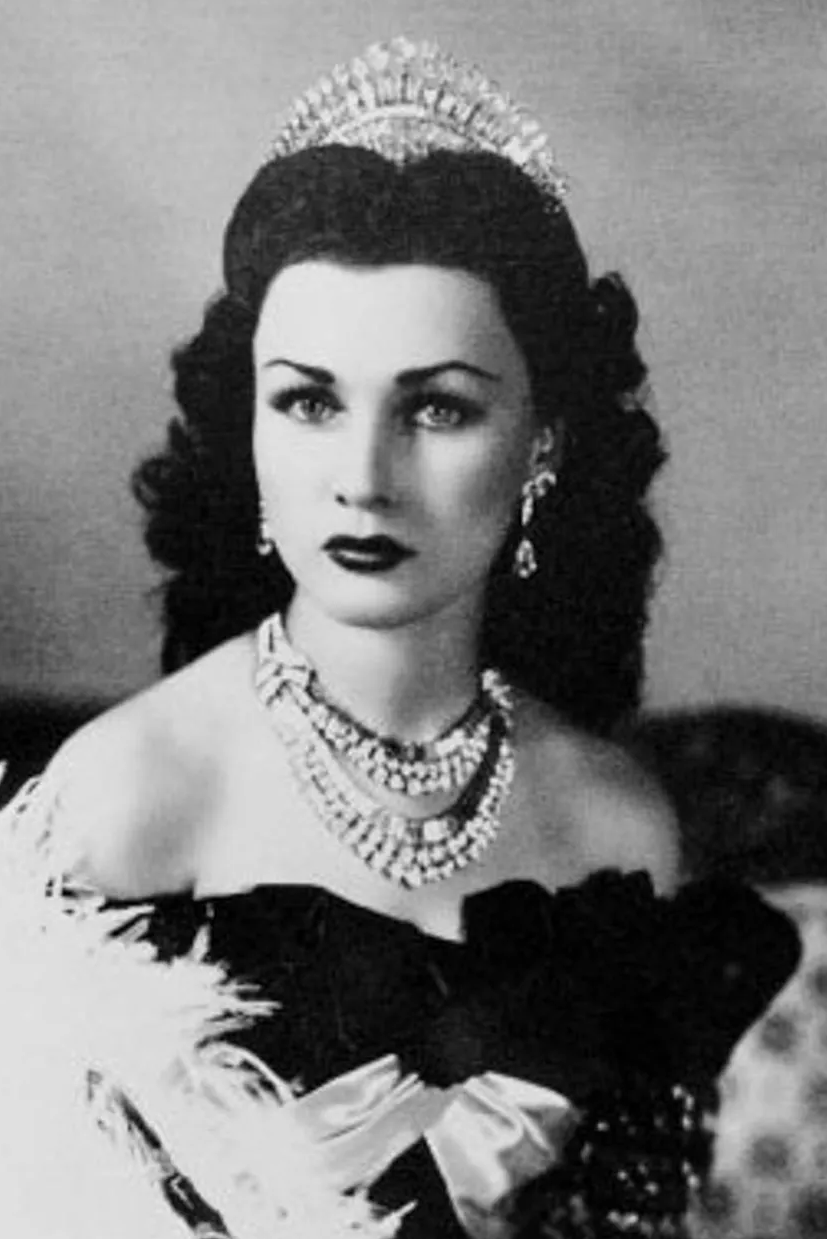
Nothing was stopping Reza Shah from getting what he wanted … not even the constitution.
Thus the Iranian parliament passed a law declaring Fawziya “Iranian by origin,” allowing the marriage to proceed without formally breaching constitutional constraints.
Princess Fawziya lived in Tehran’s Marble Palace with her husband for about a year during his crown prince years. However, the marriage soon proved strained.
Fawziya, accustomed to the cosmopolitan life of Cairo, found Tehran stifling. Reports at the time noted her lack of interest in court affairs and her reluctance to adapt to Iranian society.
British diplomats even suggested she spend “less time buying clothes and more time learning Persian” in an effort to improve the image of the royal household.
Mohammad Reza also found the marriage troubling.
The choice had been his father’s, not his.
And the young heir didn’t yet have the courage to object.
He tried to come to terms with it, but the marriage was never built to last … a story we’ll return to another time.
How Reza Shah Prepared His Son for the Throne
During this time, Reza Shah intensified his direct involvement in his son’s formation. Their relationship, once marked by emotional distance and formality, became more structured through daily meetings, focused not on family matters, but on governance, duty, and statecraft. These regular encounters became a mechanism of mentorship and control. While the dynamic remained hierarchical, Reza Shah increasingly brought his son into the machinery of state.
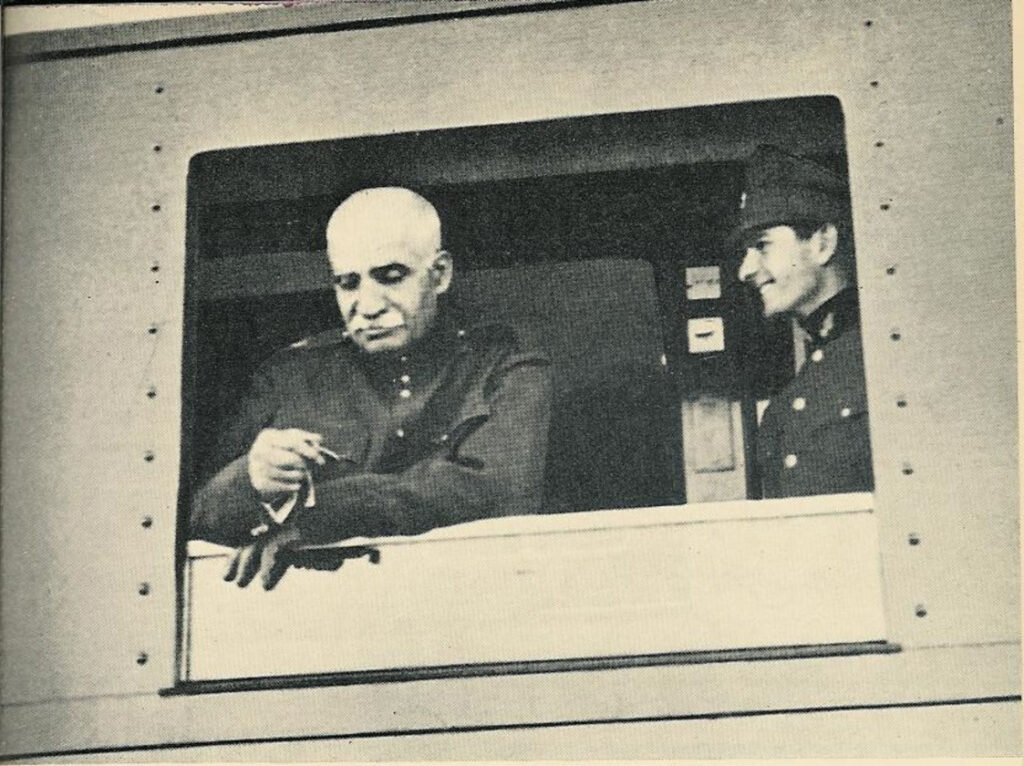
Mohammad Reza began accompanying his father on official trips across the country, learning not just protocol but also exposure to power in action. He was assigned the role of army inspector, a position with symbolic authority and practical experience. As his confidence grew, Reza Shah began to consult him in state affairs. This was not delegation out of trust or intimacy; it was succession planning.
The old king was training the new one by walking him through the routines of control.
Still, in their time together, there was no doubt about the emotional weight this relationship carried. Reza Shah saw his son not just as a prince but as a project—one that had to succeed for the entire system to be justified. And Mohammad Reza, despite the layers of formality imposed on their relationship, appeared to crave both approval and affection from a man who showed little of either.
Legacy Over Love: The Father-Son Dynamic That Defined a Dynasty
There are accounts suggesting that Reza Shah even heeded some of his son’s advice, though always within the tightly bounded frame of a father who expected loyalty, not challenge.
In these final years before abdication, Reza Shah’s method of instruction was consistent: observe, absorb, replicate. And if the bond between father and son never softened into warmth, it at least solidified into a working partnership—one in which duty served as both the medium and the message.
The relationship between Reza Shah and Mohammad Reza was a reflection of the Pahlavi dynasty’s core belief:
Control before comfort.
Legacy before love.
In preparing his son to inherit the throne, Reza Shah passed down the instruments of power—but not the warmth of a father’s hand.
Discipline mattered more than affection. Distance more than tenderness.
The bond they shared was forged from duty, not closeness.
It was reverence without intimacy. Expectation without grace.
But when the time came to pass the crown, it didn’t happen on Reza Shah’s terms.
In the next episode of The Lion and the Sun, global war erupts.
And Iran’s king—once the architect of a new empire—finds himself alone.
His kingdom at the brink of extinction.

